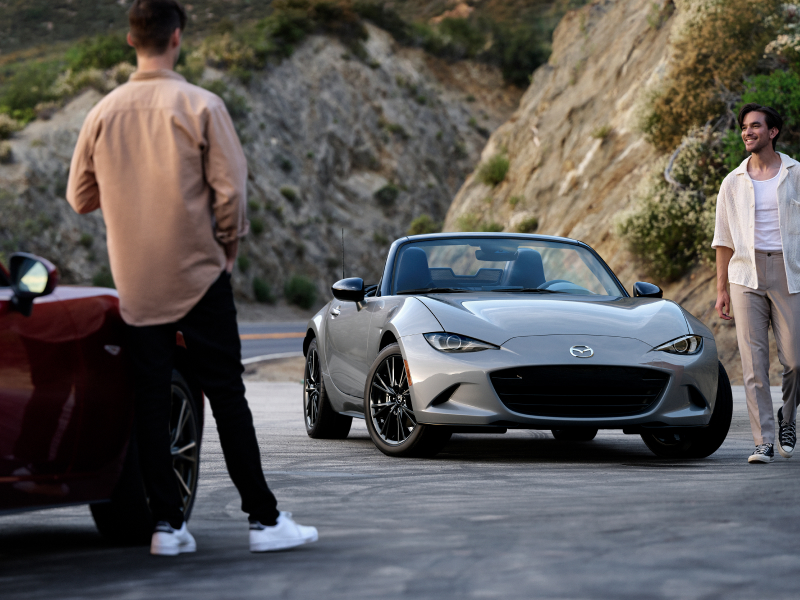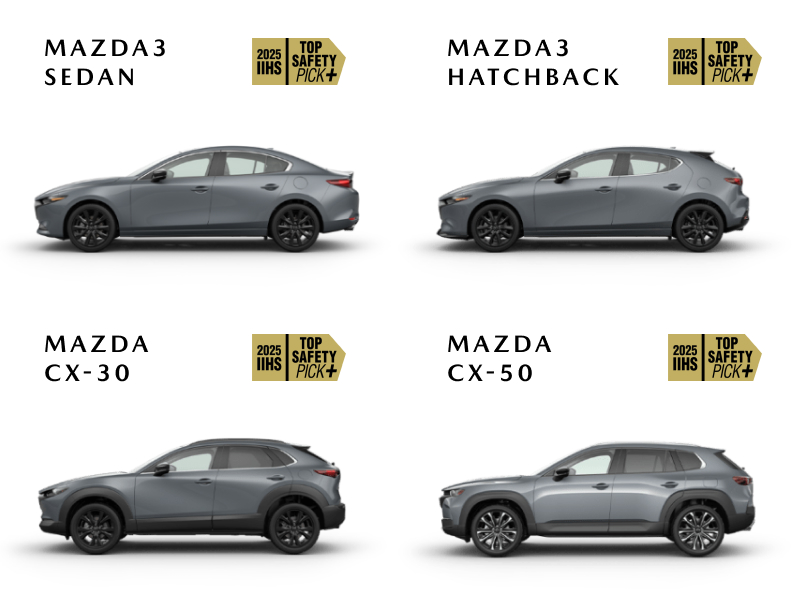Having a Teen Driver Changes What’s in the Driveway

As parents navigate the challenges of raising teen drivers, their vehicle choices evolve to meet new priorities and concerns. A recent Mazda survey of 1,776 parents and guardians with children under 18 at home reveals how these changing needs impact the decision-making process when it comes to family vehicles. From an increased focus on safety features and cargo space to considering whether a teen’s first car should be new or used, parents are making choices that reflect their growing children’s needs.
This article explores how parents of teen drivers are adjusting their vehicle preferences, including a shift toward larger SUVs and crossovers, as well as the importance of safety ratings.
For parents looking to balance practicality with style, Mazda offers a range of vehicles that combine advanced safety features with durability, making them an excellent option for families with teen drivers.
Parents of teen drivers navigate new priorities behind the wheel
Nearly all parents (96%) in our survey reported that parenthood has impacted their vehicle choices. Key factors influencing the types of vehicles driven include a stronger preference than before for vehicles with more seating capacity (48%), higher safety ratings (47%), and more cargo and storage capacity (46%).
Naturally, the factors influencing the types of vehicles parents drive evolve over time. For instance, parents of non-driving children are 37% more likely to say since having kids they prefer driving vehicles that offer easy installation and accessibility to car seats, whereas parents with at least one teen driver are 18% more likely than parents with non-driving children to say since having kids they now prefer driving vehicles with advanced safety and driver assistance features. This isn’t to say that parents of non-driving children don’t care about safety features — 38% of those parents selected that as an option — it's clear that as their children grow, their driving needs and concerns shift, leading to a stronger emphasis on different features.
The priority of certain concerns changes over time, too. When asked, “What are your three biggest concerns when driving with your children?” the top choices for all parents, regardless of whether or not they have a teen driver, were children’s safety in case of an accident (55%), other drivers’ behavior and road conditions (43%) and a tie of keeping children entertained and managing children’s behavior and distractions (both 32%).
These top 3 choices remained roughly the same even when splitting parents of teen drivers vs. all other parents, but other distinctions did emerge:
• Of parents surveyed who agreed that driving with their children comes with additional challenges and concerns, parents with at least one teen driver were 50% more likely than other parents to select having enough cargo space for child-related items as one of the top 3 situations that concerned them the most (30% vs. 20%).
• Of parents surveyed who agreed that driving with their children comes with additional challenges and concerns, parents with at least one teen driver were 38% more likely than other parents to select managing heating and cooling in the rear as one of the top 3 situations that concerned them the most (29% vs. 21%).
• Of parents surveyed who agreed that driving with their children comes with additional challenges and concerns, parents with non-driving children were 42% more likely than parents of teen drivers to select focusing on driving with crying or upset children as one of the top 3 situations that concerned them the most (27% vs. 19%).
To paraphrase, once parents of younger kids move past the stage of managing distractions and keeping their children calm, their concerns shift to things like cargo space for gear and managing cabin temperature since those issues start to affect older kids more. It seems that at all stages of children’s lives, parents are constantly balancing comfort, safety, and keeping everyone content on the road.
Parents of teen drivers are trading up for larger vehicles and more cargo space
82% of parents with at least one teen driver have purchased a different type of vehicle to better fit their family’s lifestyle and needs, making them 9% more likely to have done so than parents without a teen driver. But what types of vehicles are parents of teens buying?
Of the parents who stated they have purchased a different type of vehicle to better fit their family’s lifestyle and needs, parents with at least one teen driver are most likely to have purchased the following types of vehicles:
• 3-row SUV or crossover: 40%
• 2-row SUV or crossover: 33%
• Minivan: 28%

These choices align with overall trends in vehicle types purchased by all parents: 3-row SUVs or crossovers (35%), 2-row SUVs or crossovers (34%), sedans (27%), and minivans (26%), although per the above, minivans take a slight edge for parents with teens. As we’ll discuss in a minute, many parents of teens believe that sedans are the ideal car for teens, so the purchase of these larger vehicles may be indicative of parents buying vehicles for themselves and passing along their sedans to their teen drivers.
Car comparison guides:
• Sedans vs. SUVs
• SUVs vs. Minivans
• Choosing the Best SUV for Your Family
Also of note is that, of the parents who stated they have purchased a different type of vehicle to better fit their family’s lifestyle and needs, parents with at least one teen driver are 83% more likely than all other parents to say they bought a sports car (11% vs. 6%). You can read more about which parents are more likely to buy their teen a sports car in our article on the ways moms and dads navigate the car-buying process.

Of the parents who stated they had purchased a different type of vehicle to better fit their family’s lifestyle and needs, parents with at least one teen driver were also 21% more likely than all other parents to say they bought a 3-row SUV or crossover (40% vs. 33%).
This shift may be explained by how the same group of parents responded when asked which life events prompted them to purchase a different vehicle for their family. Many parents of teen drivers (44%) and parents of non-drivers (40%) select that their children getting older and needing more room is a motivating factor, but parents of teen drivers were 27% more likely than parents with non-driving children to say their children joining sports or extracurricular activities triggered the purchase (33% vs. 26%).
To put it another way, the need for extra cargo space and seating to accommodate sports equipment and teammates can be a significant motivator for parents of teen drivers when purchasing new vehicles.
Parents of teens prioritize trusted safety ratings when purchasing vehicles
When asked how important were safety ratings from organizations like the Insurance Institute for Highway Safety (IIHS) or the National Highway Traffic Safety Administration (NHTSA) when purchasing a vehicle, the majority (84%) of all parents stated that these safety ratings were important. Only 14% felt neutral about safety ratings, and a mere 2% stated that these ratings were not important.

Parents of teen drivers were actually 5% more likely to view safety ratings from organizations like IIHS or NHTSA as important (87% vs. 83%). This difference might speak to parents considering whether or not they would feel safer with their teens driving their vehicles. It could also be a generational difference.
Along these same lines, when asked which sources they rely on to determine a vehicle’s overall safety, parents of teen drivers agreed with parents of non-drivers that test drive experiences and personal impressions, Consumer Reports reviews and ratings, and ratings from safety organizations (e.g., NHTSA) took precedence, but were 25% less likely than parents of non-driving children to select social media (e.g., Instagram, Facebook, TikTok, etc.) as a source to rely on to determine safety.
It’s unclear if this reflects a generational preference, a perception that social media is less reliable or authoritative for technical details like vehicle safety, a tendency among parents of teens to prioritize expert advice and data-driven sources over online trends, a combination of the above, or neither.
Most parents plan to pass down their car — often well before teens start driving
When asked whether they plan to give one of their current vehicles to their children when they become a teen driver, the majority of all parents (62%) said that they did, about a quarter (21%) said they weren’t sure, and the remainder said they did not plan on doing this (16%) or had already done so (1%).
As you might expect, parents of teen drivers — who are closer to making this decision — were 15% more likely than parents of non-driving children to say they planned to give their teen one of their vehicles. However, the majority of parents with non-driving children also plan to pass on one of their current vehicles.
Did these parents, regardless of their children's driving status, always consider this in their vehicle purchase decisions? It turns out that many did. 30% cited this as a primary factor, 30% as an important factor, and 14% as a minor factor. Only 27% of parents planning to pass down their vehicle did not consider this at all when purchasing.
Parents of teens were 37% more likely to cite the decision to give their vehicle to their child as a primary factor in their vehicle purchase, while parents with non-driving children were 50% more likely than parents of teens to say it was a minor factor.
Simply put, most parents, regardless of their children’s current driving status, begin thinking about passing down their car well before their kids are old enough to drive.
Parents of teens still prefer that their teens drive sedans and used cars, but this may be changing
When asked which type of vehicle they believe is most suitable for teen drivers, the majority of parents (44%) selected sedans. The only other vehicle type to receive double-digit support was 2-row SUVs or crossovers, with 17%.
Parents of teen drivers generally followed these overall trends but were 31% more likely than parents of non-driving children to choose a 2-row SUV or crossover as the most suitable vehicle for teens (21% vs. 16%).
As noted above, since most parents of teen drivers who purchased a new vehicle opted for a 3-row SUV or crossover (40%), 2-row SUV or crossover (33%), or minivan (28%), they're likely either handing down their sedan to their teens and upgrading to a larger vehicle or now have two SUVs parked in the driveway. It may also be that parents are responding to the increased presence of larger vehicles on the road by choosing similar options for their children.
Regardless of whether teen drivers are driving a sedan or an SUV, chances are that it’ll be used. We asked parents if, in their opinion, a teen driver’s first vehicle should be new or used, and the majority (61%) said used. 20% of parents toed the line and said that this decision depends on individual circumstances, 17% stated that a teen driver’s first vehicle should be new, and only 2% did not state a preference.
Parents of teen drivers were 40% more likely than all other parents to state that a teen driver’s first vehicle should be new (21% vs. 15%), while parents with non-driving children were 11% more likely than parents with at least one teen driver to state that a teen driver’s first vehicle should be used (62% vs. 56%). This could suggest that while parents may initially plan to pass on a used vehicle, they ultimately choose to purchase a new one for their teen driver.
Buying a vehicle for your teen? Explore new, certified pre-owned, and used Mazda vehicles
Choosing the right first car for your teen involves balancing budget, safety, and key features like advanced driver assistance systems (ADAS). IIHS and NHTSA ratings, along with solid crash test ratings, can offer peace of mind when it comes to protecting your teen. Mazda combines safety, style, and reliability, making it a great option for parents looking for a trustworthy vehicle for their teen. See the IIHS “safe vehicles for teens ” recommendations.
By making safety a priority and selecting a brand like Mazda, you give your teen the opportunity to drive a car that’s safer, elegant, and stylish. From the family-friendly 3-row CX-90 and 2-row CX-70 and their plug-in hybrid counterparts, the CX-90 PHEV and CX-70 PHEV, Mazda has no shortage of options that cater to families who are looking to upgrade to a larger vehicle. Or if you’re one of the many parents who want their teen to drive a sedan, the Mazda3 Sedan offers a sleek design with all the performance benefits Mazda is known for.
Get started today by comparing our new, certified pre-owned , and used vehicles, or visit your local Mazda Dealer today.
More Buyers Guides for Parents:
• SUVs for Teens
• How to Transfer a Car Title to a Family Member
• What Is a Good Alternative to a Minivan?
• Things to Consider When Buying a Used Car
• What Is a Good First Car for Teens?
Methodology
The findings presented in this article are the result of a July 2024 study of 1,776 U.S.-based parents who own and drive at least one vehicle. In this study, “parents” are defined as adults who are the parent or guardian of at least one child who is 18 years old or younger. (Confidence Level: 95%, Margin of Error: 2%)
This article is intended for general informational purposes only and is based on the latest competitive information available at the time of posting. Information herein is subject to change without notice and without Mazda incurring any obligations. Please review a variety of resources prior to making a purchasing decision. Visit Resource Center for more articles.




















